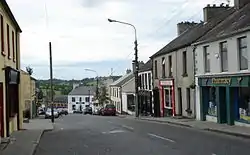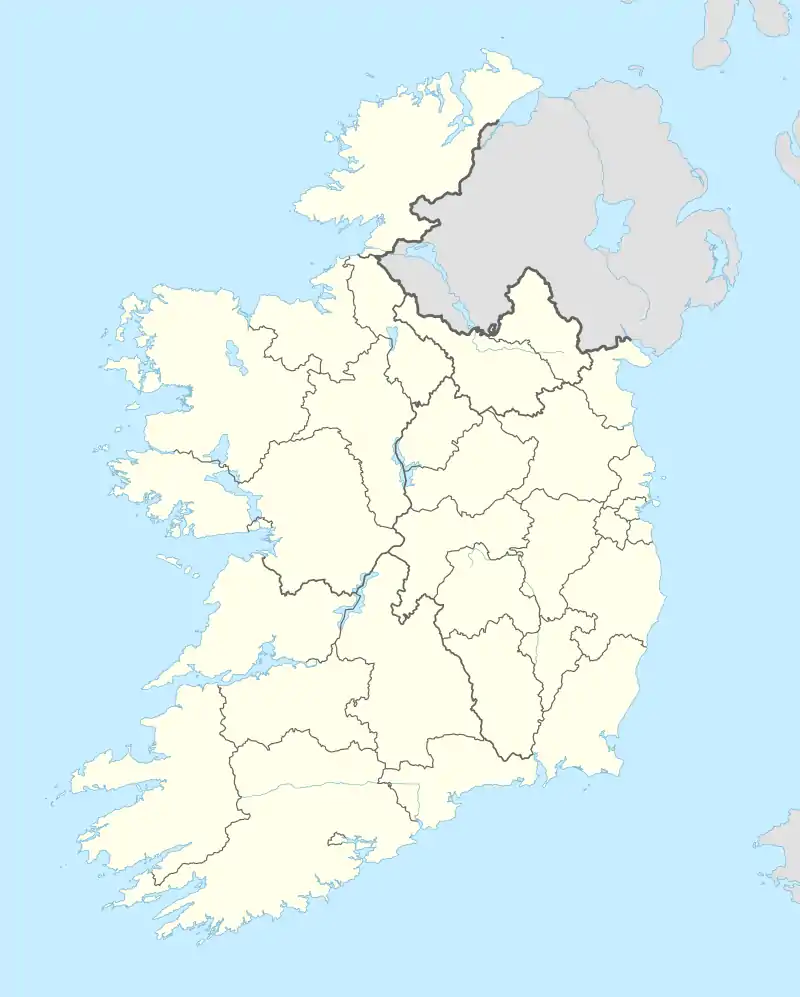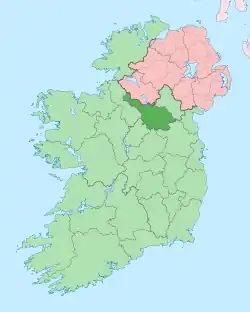Killeshandra
Killeshandra or Killashandra (Irish: Cill na Seanrátha, meaning "the church of the old ring-fort"),[2] is a village in County Cavan, Ireland. It is 20 kilometres (12 mi) northwest of Cavan Town in the centre of County Cavan's lakeland and geopark region and the Erne catchment environment of rivers, lakes, wetlands and woodland. Together with the Lough Oughter Special Protected Area (SPA), it has been recognised by the EU programme for wildlife Natura 2000 since 2010. Killeshandra is noted by Fáilte Ireland as an "Angling Centre of Excellence", and as a hub for the Cavan Walking Festival which takes place in May each year. There are several looped walking and cycling trails in Killykeen Forest Park. The town is also home to Killeshandra Gaelic Football Club, known locally as the Killeshandra Leaguers.
Killeshandra
Cill na Seanrátha | |
|---|---|
Village | |
| Killashandra | |
 Main Street | |
 Killeshandra Location in Ireland | |
| Coordinates: 54.01523°N 7.52894°W | |
| Country | Ireland |
| Province | Ulster |
| County | County Cavan |
| Elevation | 66 m (217 ft) |
| Population (2016)[1] | 388 |
| Irish Grid Reference | H308074 |
History
Killeshandra owes its name to the old Church of the Rath (built originally in the 14th century by monks from Drumlane priory. The town was created during the Ulster Plantation, when Sir Alexander Hamilton of Innerwick, Scotland was granted lands by the crown in July 1610 to build a castle and create a Protestant community around the barony of Tullyhunco. The 1641 rising and civil war was a particularly difficult period in Killeshandra's history, as the Hamiltons with their neighbours the Craigs were forced out of their settled lands by the O'Reillys. It was not until after the war, during the Restoration period, that Sir Francis Hamilton regained control of the area. He set about building a market town with Scottish planters and migrant Huguenot settlers who were especially noted for their industry and thrift. The new settlers and their families quickly adapted to the local conditions, beginning to grow flax and process linen in the Cavan region. The earliest papal records of a church building in the area date from the fourteenth century on the site of a former rath (fort), then a dependency of Drumlane priory referred to as the 'Church of the Rath'. From the early 17th century the church was "reformed" for Protestant use and included the glebe lands allocated by the Hamiltons to the Anglican Kilmore diocese, for Scottish Episcopalian worship. Later in the century when peace was restored, the church was remodelled after the death of Sir Charles Hamilton in 1688. Recreated by the family (Barons of Castle Hamilton) as a lasting memorial to departed members of the original Scottish Hamilton family. The remains of this church today form part of a protected monument and can still be seen at the lower end of the town (opposite Lakeland Dairies). This church displays some unusual architectural characteristics; it is T-shaped, with a south-facing transept in the Renaissance neo-classical style, described in the Pevsner Guide to South Ulster as "arguably the finest Restoration building in Ulster, a handsome evocation of the improving architectural eloquence of the age". The east-facing window is in the more traditional Gothic style. Hamilton heraldic embellishment is visible on the south gable wall and gate pillars. When a new Anglican church was built (circa 1842) further up the main street, some of the earlier Hamilton family memorials attributed to well-known Irish sculptor William Kidwell were brought from the old church and placed inside the new building, where they can still be seen. The graveyard continued in "mixed" community use for well over a century after the church was closed; it is now also protected as a National Monument. This graveyard includes some interesting 19th-century mausoleums and heraldic memorials from families dating back to the early 18th century.
Linen production around Killeshandra grew considerably following an incentive in 1760 from the Linen Board. It was later described in Pigot's 1824 Directory as "[t]he greatest linen market in the county, and the inhabitants of the town and neighbourhood are principally employed in its manufacture". However, failure to capitalise on industrial methods of linen production when market sales approached their peak meant that Killeshandra would inevitably lose in the race to compete with the bigger linen-exporting towns further north, eventually causing hardship and destitution for many local flax growers and linen producers.
The Missionary Sisters of the Holy Rosary were founded in 1924 in Killeshandra, and are sometimes referred to as the Killeshandra Nuns.[3]
Population and demographics
According to the CSO 2016 census, at that time Killeshandra's population stood at 388 persons,[1] an increase of 6.6% from 364 in the 2011 census,[4] which in turn showed an 11% drop in population from the 2006 census. Compare population levels in 1911, when the town population was 566 persons (46% higher than present levels).[5] However, in the electoral division, which includes the town and surrounding district, a slight increase in population up to 1,141 persons was recorded in 2011.[6] In previous centuries, when there were several thousand people living near Killeshandra, local industry and agriculture sustained the local population.
Economic changes
Throughout the twentieth century, Killeshandra's economy was based on its agriculture base, while Killeshandra Creamery became one of Ireland's leading dairy and milk processing co-operatives. At one time Killeshandra was a hub of industry in the region, with several flax and corn mills in addition to Fletcher's sawmill, which was built on the site of an earlier brewery. From the 1860s the town was serviced by a railway line to Crosdoney and Cavan. However the closure of the railway to goods and passengers in 1960 was the first significant result of population decline throughout the region. The eventual closure of Fletcher's sawmill and the demise of street market trading would also signal the end for Killeshandra's linen market house, built around 1790 by then-landlord Robert H. Southwell. The market house fell into disrepair and was finally demolished in the late 1960s.
Today Killeshandra, in addition to being a base for the Lakeland Dairy Company, is as tourist destination within County Cavan for anglers, walkers and wildlife enthusiasts. The Lough Bawn Hotel is located in the middle of the village and there are several B&Bs nearby. Killeshandra has shops, two national schools, denominational churches, restaurants and several pubs. A community hall was completed in September 2013, replacing a hall built in the 1970s. The new hall has a large open space for indoor sporting events, as well as space for dancing, concerts and exhibitions.
Public transport
Bus
From September 2018, Local Link Cavan-Monaghan route 929 will serve the town with four journeys in each direction, linking the town with Cavan, Newtowngore and Ballinamore. The town is also served by several Local Link Cavan Monaghan door-to-door routes.[7]
Bus Éireann serves the town once weekly on Tuesdays, with route 465 providing a return journey to Cavan via Arvagh and Ballinagh, and a one-way to journey to Carrigallen.[8]
Rail
Killashandra railway station was the once terminus of a short branch railway line between Cavan and Crossdoney on the Midland Great Western Railway line. Opened in 1886, the Killeshandra branch line, along with the Crossdoney to Cavan line, discontinued passenger service in 1947. The line remained open for goods traffic until 1959, then was closed completely in January 1960. Most of the rail infrastructure is now gone, but the station and a nearby goods shed still remain.
Dairy industry
Lakeland Dairies, which is the second largest dairy co-operative and third largest dairy processor in Ireland, has its headquarters in Killeshandra.
The dairy industry in Killeshandra began when the Drummully Co-operative Society was founded on 23 September 1896. A committee decided to establish a creamery in Killeshandra when local farmers promised the milk from 987 cows. In March 1898, the new dairy business became known as the Killeshandra Co-operative Agricultural Society. That business was successful, winning prizes for butter and dairy products at home and abroad. In 1996, a century after its founding, Killeshandra Co-op was handling the milk from over 4,000 farmer suppliers. Today this co-op has transformed through mergers with other companies to form Lakeland Dairies.
The Lakeland Dairies co-operative operates on a cross-border basis, employing over 800 people and has 2,400 dairy farmers supplying milk to the co-operative across 15 counties.
In October 2013, Lakeland Dairies purchased the former Ulster Bank premises in Killeshandra town, next door to the company's headquarters.
People
- Michael Donohoe, former Democratic U.S. Representative of Pennsylvania, born in Killeshandra.
- William Farrell, designer of the Killeshandra Church of Ireland building.
- William Hales, author and for 43 years rector of Killeshandra.
- Stephen King, former Cavan Gaelic football star.
- Thomas Lough, pioneer of Killeshanadra Co-operative Agricultural & Dairy Society. Also liberal MP for West Islington, London.
- John Joe O'Reilly, former Cavan Gaelic football star.
- Philip O'Reilly, former MP for Cavan and 1641 Rebellion leader.
- Tom O'Reilly, former Cavan politician.
- Eamonn Owens, actor in The Butcher Boy (film).
- George Richardson (VC) of Derrylane, Killeshandra.
In popular culture
- The Ohioan Irish folk band Brady's Leap has released a CD entitled The Road to Killeshandra. William Greenway, poet and Professor of English at Youngstown State University, sings on the title track.
- Dominic Behan's song Come Out Ye Black and Tans refers to the "green and lovely lanes of Killeshandra".
- In the Irish folk song Cavan Girl, the first-person narrator walks "the road from Killeshandra" that runs "twelve long miles around the lake to get to Cavan town".
Further reading
- Images and Echoes of Killeshandra 1899-1999. Killeshandra Community Council. 1999., mostly community photographs spanning twentieth century.
- Matty Gaffney (2009). Life Recorded. An excellent pictorial and personal account of a changing Killeshandra from the 1930s onwards.
- Pevsner Architectural Guide to the Buildings of Ireland - South Ulster - Armagh, Cavan and Monaghan by Kevin V. Mulligan (2013) Includes several references to buildings in and around Killeshandra.
- An Introduction to the Architectural Heritage of County Cavan - published by the Department of Arts Heritage and the Gaeltacht (2013). Part of the national architectural heritage survey which includes several references to buildings in and around Killeshandra.
- The Ulster Plantation in Counties of Armagh and Cavan 1608-1641 by R.J. Hunter (2012) includes several historic references to Killeshandra.
- Tomas O'Raghallaigh (2010). Turbulence in Tullyhunco (pdf). Book refers to Killeshandra area before, during and after the Ulster Plantation.
- Tomas O'Raghallaigh (2016). Revolution in Tullyhunco. How tenants got back the land lost in the Ulster Plantation (1809-1903)
- The Village Institute Killeshandra 1907-1957. Killeshandra Community Council. 2011.
- Conservation and Management Plan of Jacobean Church, Killeshandra, Co.Cavan - June 2013 - published by Cavan County Council & The Heritage Council.
- Killeshandra St.Brigid's School/Scoil Bhride Reunion "Legacy of Learning" 3 June 2017
See also
- List of towns and villages in Ireland
- Market Houses in Ireland
- Irish linen
References
- "Census 2016 Sapmap Area: Settlements Killeshandra". Central Statistics Office (Ireland). Retrieved 20 March 2019.
- "Cill na Seanrátha/Killashandra". Placenames Database of Ireland. Government of Ireland - Department of Arts, Heritage and the Gaeltacht and Dublin City University. Retrieved 19 March 2019.
- The Holy Rosary Sisters Story www.knuns.org
- "Settlement Killeshandra (CSO Area Code ST 32016)". Census 2011. CSO. April 2011. Retrieved 31 December 2019.
- "1911 Census, Search, Killashandra". census.nationalarchives.ie. National Archives. Retrieved 31 December 2019.
- "Electoral Division Killashandra (CSO Area Code ED 32066)". Census 2011. CSO. April 2011. Retrieved 31 December 2019.
- "Timetable - Cavan Monaghan Transport Coordination Unit Ltd". www.cmtcu.ie. Retrieved 21 August 2018.
- "Cavan - Killashandra - Carrigallen" (PDF). buseirann.ie. Retrieved 8 December 2019.
External links
| Wikimedia Commons has media related to Killeshandra. |
